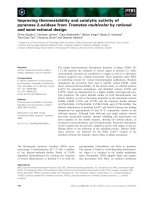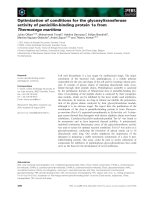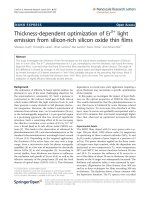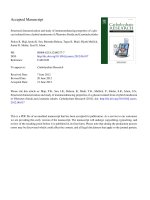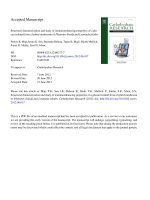OPTIMIZATION OF SPRAY DRYING CONDITION FROM TRAMETES VERSICOLOR MUSHROOM EXTRACT
Bạn đang xem bản rút gọn của tài liệu. Xem và tải ngay bản đầy đủ của tài liệu tại đây (504.55 KB, 6 trang )
<span class='text_page_counter'>(1)</span><div class='page_container' data-page=1>
<b>OPTIMIZATION OF SPRAY DRYING CONDITION FROM </b>
<b>TRAMETES VERSICOLOR MUSHROOM EXTRACT </b>
NGUYEN NGOC TUAN1, NGUYEN THI NGAN1, NGUYEN NGOC THUAN1,
NGUYEN TRAN NGOC MAI1, NGUYEN DUC VUONG1, DAM SAO MAI2,
NGUYEN TAN THANH3, TRAN DINH THANG3
<i>1</i>
<i> Viện Công nghệ sinh học và thực phẩm, Trường Đại học Cơng nghiệp Thành phố Hồ Chí Minh, </i>
<i>2</i>
<i> Phòng quản lý khoa học và hợp tác quốc tế, Trường Đại học Cơng nghiệp Thành phố Hồ Chí Minh; </i>
<i>3</i>
<i> Viện Hóa sinh mơi trường, Trường Đại học Vinh; </i>
<i> </i>
<i><b>Abstract. In this study, the optimal conditions for the spray drying from Trametes versicolor (V.C.) </b></i>
extracts were determined using response surface method/technique (RSM). One kilogram of material was
extracted with 30L ethanol 65% of 70oC for 7 hours. Solids were filtered off, extract was concentrated to
obtain solution containing about 20% total solid using a vacuum evaporator. Study on the effects of three
independent variables, namely maltodextrin ratio (% w/v), feed flow rate (ml/min) and inlet drying
temperature (oC) on the responses; total phenolic content (TPC) and moisture content (MC). The optimal
<i>conditions for spray drying process from T. versicolor extracts were found to be maltodextrin ratio of </i>
5%w/v, inlet drying temperature of 160oC and feed flow rate of 26.05ml/min. The experimental values of
TPC and MC were 35.76±0.04mg GAE/g, 4.43±0.02%.
<i><b>Keywords. Moisture content (MC), Trametes versicolor, total phenolic content (TPC), response surface </b></i>
methodology (RSM).
<b>1. INTRODUCTION </b>
For a long time, mushrooms have been used not only as traditional foods but also as medicinal
species in many countries. So far, mushrooms are still used to treat many major diseases in China, Japan,
<i>Korea and several other Asian countries. Trametes versicolor (L.:Fr.) Pil has been widely used as a </i>
medicinal ingredient in both traditional medicine and modern clinical practice [1]. Studies have shown
that in addition to nutritional value, antioxidant and anti-inflammatory activity, immune-enhancing
activity, anticancer activity, antiviral effects andantimicrobial [2]. However, in Viennam and other
<i>countries there are few studies that analyzed T. versicolor phenolic compounds composition, important </i>
for their antioxidant properties.
Spray drying is a technique of producing a dry powder from pumpable liquid or slurry using rapid
drying with a heated gas media. The physicochemical properties of powders produced by spray drying are
very much dependent on significant process variables such as air inlet temperature, maltodextrin ratio, air
pressure and feed flow rate. Other less important parameters are ignored in this study due to the
limitations of the equipment used (e.g., air outlet temperature, atomizer type and size, air humidity, drying
air flow rate). The liquid feed was assumed to be close to water characteristics (e.g., viscosity, solid
content, surface tension, solvent volatility).
</div>
<span class='text_page_counter'>(2)</span><div class='page_container' data-page=2>
<b>2. MATERIAL AND METHODS </b>
<b>2.1. Material </b>
<i>The basidiomycetes of Trametes versicolor were collected at the Pumat National Park of Nghe </i>
An Province, Vietnam in September 2018 and identified by Prof. Dr. Ngo Anh, Department of Biology,
Hue University. A voucher specimen (Vinh-TĐT 16092018) was deposited at the herbarium of the
Department of Chemistry, Vinh University.
<b>2.2. Methods </b>
<i>2.2.1. Spray drying </i>
<i>Spray drying of Trametes versicolor mushroom extract with maltodextrin as an additive (wall </i>
material) at different ratios was performed using a Buchi B-290 mini spray dryer. The mushroom extract
was then mixed with maltodextrin at a ratio of 5%, 10% and 15% (w/v), inlet temperature used to
optimize the model were 140, 150 and 160oC. Feed rates used were 20, 25, 30 ml/min. After spray drying
<i>processing, the Trametes versicolor mushroom powder thus obtained was stored in small glass jars with </i>
screw caps to evaluate their ending product quanlity.
<i>2.2.2. Moisture content (MC) </i>
The moisture content was determined based on AOAC method (AOAC, 2000). Triplicate
<i>samples of Trametes versicolor mushroom powder (5g) were weighed and dried in oven at 105ºC until its </i>
weight is constant.
<i>2.2.3. Total Phenolic Content (TPC) </i>
<i>The TPC was measured according to the method reported by Singleton et al. [3] with some </i>
modifications. This method is based on measuring color change caused by reagent by phenolates in the
presence of sodium carbonate. 1ml of sample was mixed 5ml of Folin – Ciocalteu’s solution. After 3 min,
4ml of 7.5% sodium carbonate solution was added to mixture and adjusted to 10 ml with deionized water.
The mixture was allowed to stand at room temperature in the dark environment for 60 min. The color
change was determined by scanning the wavelength at 765nm (Agilent 8453 UV – Visible
<i>Spectrophotometer) since maximum absorbance was obtained. TPC of the Trametes versicolor extract </i>
was determined as mg gallic acid equivalent using the standard curve prepared at different concentrations
of gallic acid (10-60 μg/ml, y = 0.011x – 0.005; R2 = 0.998) and reported as mgGAE/g dry weight (DW).
<i>2.2.4. Experimental design </i>
Response Surface Methodology was used to determine the optimum levels of maltodextrin ratio
(% w/v), feed flow rate (ml/min) and inlet drying temperature (oC) as drying on two responses
<i>namelyTPC and MC in the Trametes versicolorextracts spray-drying. These three factors, namely </i>
maltodextrin ratio (A), inlet drying temperature (B) and feed flow rate (C) were coded into three levels
(-1, 0, +1). The coded independent variables used in the RSM design are shown in table 1. Ranges of
maltodextrin ratio, inlet drying temperature and feed flow rate and the central point were selected based
on preliminary experimental results [4-10].
<b>3. RESULTS AND DISCUSSION </b>
<b>3.1. Model Fitting </b>
</div>
<span class='text_page_counter'>(3)</span><div class='page_container' data-page=3>
Table1: Coded level of independent variables used in the RSM design
Independent variables Coded symbols Coded variable levels
-1 0 +1
Maltodextrin ratio (%) A 5 10 15
Inlet drying temperature (oC) B 140 150 160
Feed flow rate (ml/min) C 20 25 30
The effects of the extraction parameters were evaluated using the program Design- Expert®,
version 7.0.0. The response variable was fitted be a second- order polynomial model as follows:
∑
∑ <sub> </sub>
∑ ∑ <sub> </sub>
Table2: Experimental Design and Response Values
RUN Maltodextrin
ratio
A (%w/v)
Inlet drying
temperature
B (oC)
Feed flow
rate
C (ml/min)
TPC
Y1
(mgGAE/g)
MC
Y2
(%)
1 - - 0 37.69 5.37
2 - + 0 36.48 4.41
3 + - 0 29.79 7.16
4 + + 0 28.08 4.59
5 0 - - 34.79 6.43
6 0 + - 32.95 4.54
7 0 - + 35.04 6.63
8 0 + + 34.58 4.87
9 - 0 - 36.72 5.72
10 + 0 - 28.42 6.53
11 - 0 + 37.25 5.91
12 + 0 + 29.26 6.83
13 0 0 0 34.12 6.04
14 0 0 0 34.03 6.09
15 0 0 0 34.18 6.01
16 0 0 0 34.21 6.03
17 0 0 0 34.24 6.06
The values of the two evaluation indices for each spray-drying condition were listed in Table 2. The
maximal TPC was 37.69 mgGAE/g at maltodextrin ration5%w/v,Inlet drying temperature 140oC and feed
flow rate 25mL/min; The minximal MC was 4.41% atmaltodextrin ration 5%w/v, Inlet drying
temperature 160oC and feed flow rate 25ml/min. From the multiple linear regression analyses of the
17data entries, empirical second-order polynomial models of TPC and MC scavenging capacity were
derived (Table 3).
Table3: Empiric second- order polynomial model of TPC and MC
Response Model equations R2 p-value
Y1 – TPC Y1= 35.35- 0.28A-2.09B + 0.95C - 0.075AB + 0.69AC +
0.093BC + 0.14A2 – 0.46B2 +0.17C2 0.9993 <0.0001
Y2 – MC Y2= 6.29– 0.78A + 0.30B + 1.12C – 0.24AB + 0.065AC +
0.033BC - 0.65A2 – 0.0006B2 + 0.87C2 0.9988 <0.0001
</div>
<span class='text_page_counter'>(4)</span><div class='page_container' data-page=4>
calculated to be 1041.74; 653.29, both leading to a p-value<0.05, suggesting the both the models were
statistically extremely significant. The models’ coefficient of determination (R2) were 0.9993and 0.9988,
indicating that more than 99.93% and 99.88% of the response variability were explained, and supporting
a good accuracy and ability of the established model within the range limits used. The F-values of Lack of
Fit of Y1, Y2were 3.88; 3.30, respectively, implying that the Lack of Fit was not significant relative to the
pure error. This indicated that the accuracy of the polynomial model was adequate.
Table4: Regression coefficients of the predicted second- order polynomial models for the total
phenolic compoundsand moisture content.
Source Y1 – TPC Y2 – MC
F- value p- value F- value p- value
Model 1041.74 <0.0001*** 653.29 <0.0001***
A 13.40 <0.0081** 866.09 <0.0001***
B 1897.08 <0.0001*** 323.65 <0.0001***
C 13.57 0.0078** 155.76 <0.0001***
AB 4.04 0.0844NS 351.10 <0.0001***
AC 30.77 0.0009*** 2.29 0.1740NS
BC 1.55 0.2528NS 1.64 0.2413NS
A2 5.39 0.0532NS 954.21 <0.0001***
B2 450.62 <0.0001*** 0.64 0.4500NS
C2 0.51 0.4986NS 108.66 <0.0001***
Lack of Fit 3.88 0.1118NS 3.30 0.1396NS
R2 0.9993 0.9988
*p< 0.05; **p< 0.01; ***p< 0.001; NS: non-significant.
<b>3.2. Optimization and Model Verification </b>
Based on the empirical second- order polynomial model, the experimental data was analyzed by
RSM using the Design- Expert 7.0 software. The X- and Y- axes of the three- dimensional response
surfaces represented two factors, for maltodextrin ratio and inlet drying temperature(feed flow rate =
25ml/min), inlet drying temperatureand feed flow rate (maltodextrin ratio = 10%), maltodextrin ratio and
feed flow rate (inlet drying temperature = 150 oC). The Z- axes represented one of the four evaluation
<b>indices (TPC, MC). Twodimensional response surfaces were constructed as depicted in Fig 1. </b>
<b>A </b>
<b>B </b>
</div>
<span class='text_page_counter'>(5)</span><div class='page_container' data-page=5>
The optimal values of the independent variables were obtained by solving second - order regression
equations using a numerical optimization method. Experimental data suggested the existence of
optimization of total phenolic compound and moisture content occurred with feed flow rate 26.05ml/min,
Mmaltodextrin ratio 5%at 160oC.
Table 5: Optimum conditions, predicted and experimental values of responses on spray drying of
<i>Trametes versicolorextract</i>a.
Independent variables
Dependent variables (Response)
Optimum value
A B C Experimentalb Predicted
5 160 26.05 Y1 35.76±0.04 36.3266
Y2 4.43±0.02 4.4817
a
A, Maltodextrin ratio (%); B, Inlet drying temperature; C, Feed flow rate(ml/min); Y1, TPC (mgGAE/g);
Y2, MC (%). bMean ± standard deviation (SD) of four determinations (n= 4) from two crude extract
replications.
<b>4. CONCLUSION </b>
<i>This study showed that the optimal conditions for spray drying from Trametes versicolor mushroom </i>
<i>(V.C) extracts. The optimal conditions for process spray drying from T. versicolor extracts were found to </i>
be maltodextrin ratio of 5%w/v, inlet drying temperature of 160oC and feed flow rate of 26.05ml/min.
The experimental values of Total Phenolic Content (TPC) and Moisture Content (MC) were
35.76±0.04mg GAE/g, 4.43±0.02%.
<b>REFERENCES </b>
[1]. Chu K, Ho S, Chow A. Coriolus versicolor: a medicinal mushroom with promising immunotherapeutic values. J
Clin Pharmacol. 2002;42(9):976–84.
[2]. Puia, I. C., Aida, P., Chedea, V. S., Leopold, N., Bocsan, I. C., & Buzoianu, A. D., 2018. Characterization of
<i>Trametes versicolor: Medicinal Mushroom with Important Health Benefits. Notulae Botanicae Horti Agrobotanici </i>
<i>Cluj-Napoca, 46(2), 343-349. </i>
[3]. Singleton, V.L.; Orthofer, R.; Lamuela-Raventos, R.M., 1999. Analysis of total phenols and other oxidation
<i>substrates and antioxidants by means of Folin – Ciocalteu reagent. Meth.Enzymol. , 299, 152-178. </i>
[4]. Susantikarn, P., Donlao, N., 2016. Optimization of green tea extracts spray drying as affected by temperature
<i>and maltodextrin content, International Food Research Journal 23(3): 1327-1331. </i>
[5]. Krishnaiah D., Sarbatly R., Nithyanandam R., 2011, Optimization of spray for drying Morinda citrifolia L. Fruit
<i>extract, Journal of Applied Sciences, 11(13): 2276-2283. </i>
[6]. Kartheek A., Valerie O., 2013, Optimization of microencapsulation of probiotics in raspberry juice by spray
<i>drying, Food Science and Technology, 50, 17-24. </i>
[7]. Gulsah Caliskan , S. Nur Dirim, 2013, The effects of the different drying conditions and the amounts of
<i>maltodextrin addition during spray drying of sumac extract, Food and Bioproducts processing, 91(4), 539-548. </i>
[8]. Cortés-Rojas D.F., Souza C.R.F., Oliveira W.P., 2015, Optimization of spray drying conditions for production
<i>of Bidens pilosa L. dried extract,Chemical engineering research and design, 93, 366-376. </i>
</div>
<span class='text_page_counter'>(6)</span><div class='page_container' data-page=6>
[10]. Hong J.H., Choi Y.H., 2007, Physico-chemical properties of protein-bound polysaccharide from Agaricus
<i>blazei Murill prepared by ultrafiltration and spray drying process, International Journal of Food Science and </i>
<i>Technology, 42, 1–8 </i>
<b>TỐI ƯU HÓA ĐIỀU KIỆN SẤY PHUN ĐỐI VỚI DỊCH CHIẾT NẤM VÂN CHI </b>
<i><b>(TRAMETES VERSICOLOR) </b></i>
<b> </b>
<b>Tóm tắt.Trong nghiên cứu này, chúng tơi tiến hành tối ưu hóa các điều kiện sấy phun đối với dịch chiết </b>
<i>nấm vân chi (Trametes versicolor), sử dụng phương pháp đáp ứng bề mặt (RSM). Nấm vân chi (1kg) </i>
được ngâm chiết với ethanol 65% (30L) ở 700<sub>C trong thời gian 7 giờ. Sau đó, dịch chiết được lọc bỏ phần </sub>
rắn, loại bỏ dung môi dưới áp suất thấp đạt độ ẩm 20%. . Chúng tôi tiến hành nghiên cứu ảnh hưởng của
ba yếu tố độc lập, tỉ lệ maltodextrin (% kl/v), tốc độ dòng (ml/phút) và nhiệt độ sấy đầu vào (0<sub>C) nhằm </sub>
khảo sát tổng hàm lượng phenolic (TPC) và độ ẩm (MC). Điều kiện tối ưu để sấy phun dịch chiết nấm
vân chi được xác định là tỷ lệ maltodextrin 5% kl/v, nhiệt độ sấy đầu vào 160o<sub>C và tốc độ dòng cấp liệu </sub>
<b>26,05ml / phút. Giá trị thực nghiệm của TPC và MC là 35,76 ± 0,04mg GAE / g, 4,43 ± 0,02%. </b>
<i><b>Từ khóa.Độ ẩm (MC), Trametes versicolor, tổng hàm lượng phenolic (TPC), phương pháp đáp ứng bề </b></i>
mặt (RSM)
</div>
<!--links-->

